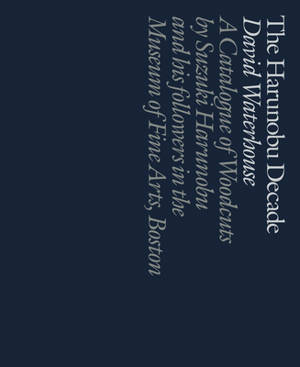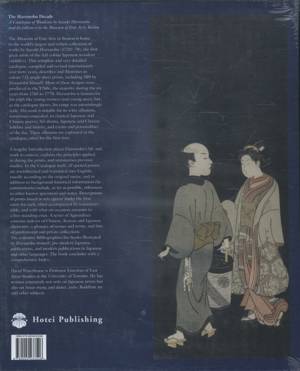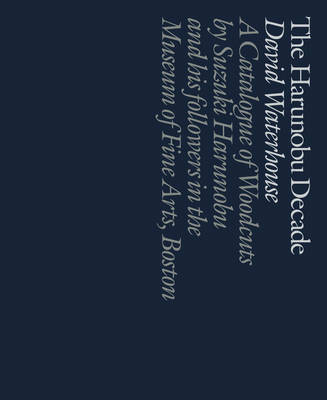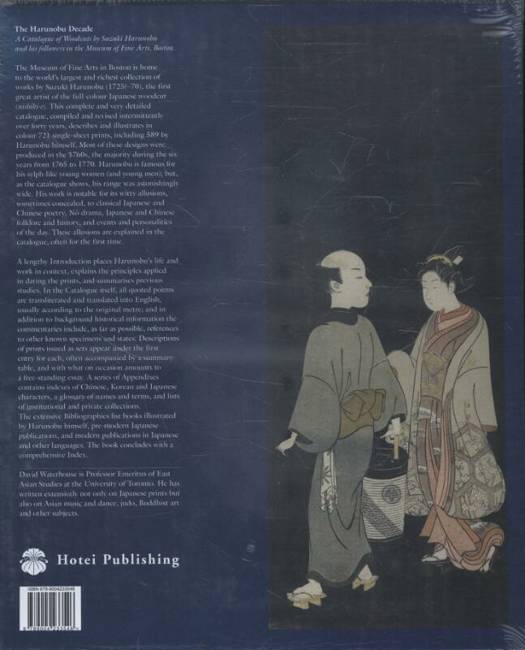
- Afhalen na 1 uur in een winkel met voorraad
- Gratis thuislevering in België vanaf € 30
- Ruim aanbod met 7 miljoen producten
- Afhalen na 1 uur in een winkel met voorraad
- Gratis thuislevering in België vanaf € 30
- Ruim aanbod met 7 miljoen producten
Zoeken


The Harunobu Decade
A Catalogue of Woodcuts by Suzuki Harunobu and His Followers in the Museum of Fine Arts, Boston
David Waterhouse
Hardcover | Engels
€ 301,45
+ 602 punten
Omschrijving
The Museum of Fine Arts in Boston is home to the world's largest and richest collection of works by Suzuki Harunobu (1725?-70), the first great artist of the full-colour Japanese woodcut (nishiki-e). This complete and very detailed catalogue, compiled and revised intermittently over forty years, describes and illustrates in colour 721 single-sheet prints, including 589 by Harunobu himself. Most of these designs were produced in the 1760s, the majority during the six years from 1765 to 1770. Harunobu is famous for his sylph-like young women (and young men); but, as the catalogue shows, his range was astonishingly wide. His work is notable for its witty allusions, sometimes concealed, to classical Japanese and Chinese poetry, Nō drama, Japanese and Chinese folklore and history, and events and personalities of the day. These allusions are explained in the catalogue, often for the first time.
A lengthy Introduction places Harunobu's life and work in context, explains the principles applied in dating the prints, and summarises previous studies. In the Catalogue itself, all quoted poems are transliterated and translated into English, usually according to the original metre; and in addition to background historical information the commentaries include, as far as possible, references to other known specimens and states. Descriptions of prints issued as sets appear under the first entry for each, often accompanied by a summary table, and with what on occasion amounts to a free-standing essay. A series of Appendixes contains indexes of Chinese, Korean and Japanese characters, a glossary of names and terms, and lists of institutional and private collections. The extensive Bibliographies list books illustrated by Harunobu himself, pre-modern Japanese publications, and modern publications in Japanese and other languages. The book concludes with a comprehensive Index.
A lengthy Introduction places Harunobu's life and work in context, explains the principles applied in dating the prints, and summarises previous studies. In the Catalogue itself, all quoted poems are transliterated and translated into English, usually according to the original metre; and in addition to background historical information the commentaries include, as far as possible, references to other known specimens and states. Descriptions of prints issued as sets appear under the first entry for each, often accompanied by a summary table, and with what on occasion amounts to a free-standing essay. A series of Appendixes contains indexes of Chinese, Korean and Japanese characters, a glossary of names and terms, and lists of institutional and private collections. The extensive Bibliographies list books illustrated by Harunobu himself, pre-modern Japanese publications, and modern publications in Japanese and other languages. The book concludes with a comprehensive Index.
Specificaties
Betrokkenen
- Auteur(s):
- Uitgeverij:
Inhoud
- Aantal bladzijden:
- 688
- Taal:
- Engels
Eigenschappen
- Productcode (EAN):
- 9789004233546
- Verschijningsdatum:
- 1/11/2013
- Uitvoering:
- Hardcover
- Formaat:
- Genaaid
- Afmetingen:
- 257 mm x 315 mm
- Gewicht:
- 4876 g

Alleen bij Standaard Boekhandel
+ 602 punten op je klantenkaart van Standaard Boekhandel
Beoordelingen
We publiceren alleen reviews die voldoen aan de voorwaarden voor reviews. Bekijk onze voorwaarden voor reviews.









